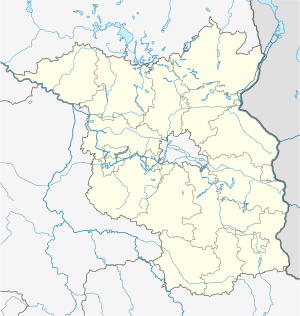Cottbus thermal power station
| Cottbus thermal power station | |||
|---|---|---|---|
| location | |||
|
|
|||
| Coordinates | 51 ° 45 '39 " N , 14 ° 22' 13" E | ||
| country |
|
||
| Data | |||
| Type | Thermal power station | ||
| Primary energy | Fossil energy | ||
| fuel | Brown coal | ||
| power | 74 MW el ; 120 MW th | ||
| owner | HKW Heizkraftwerksgesellschaft Cottbus mbH | ||
| operator | HKW Heizkraftwerksgesellschaft Cottbus mbH | ||
| Project start | 1997 | ||
| Start of operations | 1999 | ||
| turbine | Steam turbine | ||
| Firing | Fluidized bed combustion | ||
| Website | heizkraftwerk-cottbus.de | ||
The Cottbus combined heat and power plant is a brown coal-fired combined heat and power plant in Cottbus .
history
In 1968 the old combined heat and power plant in Cottbus was put into operation, initially with four steam boilers . Two identical 110 meter high reinforced concrete chimneys were completed in 1975 and four more steam boilers were built in 1980. In 1992, the preliminary decision was made to shut down the old thermal power station in 1999.
On May 9, 1997 the foundation stone was laid for the new thermal power station. Trial operations began on April 23, 1999, and commercial operations began on December 16, 1999. The old cogeneration plant ceased operations in June 1999. The two chimneys of the old cogeneration plant were blown up on July 15, 2000. In 2000, the Cottbus cogeneration plant was one of the most modern lignite-fired power plants and the world's first with pressurized fluidized bed combustion . The thermal power station was a showpiece at Expo 2000 . However, it later turned out that the technology was not mature and prone to failure. In 2005 it became known that the thermal power station caused millions in losses. In 2006, the City of Cottbus transferred 74.9 percent to DKB Proges GmbH as part of a renovation.
In 2018 it became known that the city plans to shut down the thermal power station and to build a gas-fired power station by 2022 . As a result, both the pollution of the surrounding area and. a. with fine dust and mercury as well as the carbon dioxide emissions are significantly reduced; in addition, the decision was made for economic reasons. The coal supply contract for the cogeneration plant with LEAG ends on December 31, 2019.
technology
The power plant works with a pressurized fluidized bed boiler that supplies steam for a steam turbine . This has a medium and a low pressure stage and is designed for the extraction of thermal energy for the district heating network in Cottbus. Thanks to the cogeneration of heat and power , the overall efficiency of the power plant is higher than that of power plants that only generate electricity. Including district heating extraction, up to 70% of the energy contained in the fuel can be used. Including the peak load boiler for the district heating supply, the power plant has 74 MW of electrical output and 120 MW of thermal output. The fluidized bed boiler can burn 39 tons of lignite per hour; this results in approx. 3 tons of ash. In addition, 0.6 tons of limestone per hour are used for flue gas desulphurization and 0.4 tons of quartz sand for securing the fluidized bed. In total, the power plant burns around 200,000 tons of brown coal per year.
Web links
- Homepage of the Cottbus thermal power station
- https://www.kein-tagebau.de/images/argumente/ Background_hkw_lang.pdf
- https://www.stadtwerke-cottbus.de/de/privatkunden/themen/unternehmen/ueber-uns/artikel-historie.html
Individual evidence
- ↑ Cogeneration plant costs Cottbus more money than previously known. Retrieved July 22, 2018 .
- ↑ a b Lausitz: Without coal in Cottbus . In: ZEIT ONLINE . ( zeit.de [accessed on July 22, 2018]).
- ↑ Editor: SPD wants to slow down plans for Cottbus gas power plant - Niederlausitz Aktuell . ( Niederlausitz-aktuell.de [accessed on July 22, 2018]).
- ↑ CHP today . Operator's website. Retrieved July 24, 2018.

